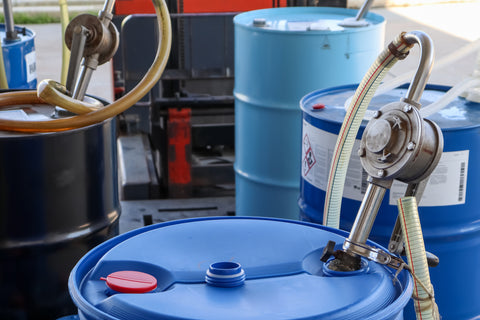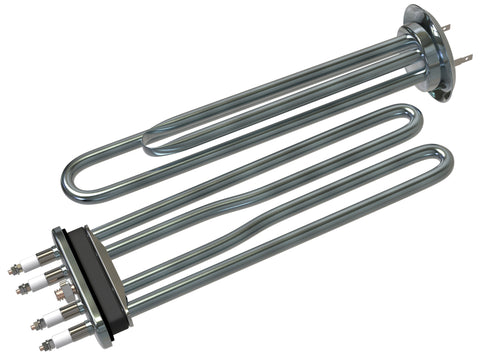The Impact of Cold Weather on 55-Gallon Drums
Will a 55-gallon Water Barrel Freeze?
A 55-gallon water tank, rain barrel, or barrel of water can freeze in cold weather. Water's freezing point is 32°F (0°C), and in cold temperatures, the water inside the barrel can freeze solid, especially if the temperatures remain below freezing for an extended period. This can cause significant damage to the barrel, especially if it is made of plastic, which may crack or break due to the expansion of ice.
How Cold Does It Have to Be to Freeze a Rain Barrel?
For a rain barrel or any water barrel to freeze, temperatures typically need to be consistently below 32°F (0°C). In colder climates, especially in the northern hemisphere, winter temperatures can cause rain barrels to freeze completely. It's essential to monitor weather forecasts and take preventive measures when a hard freeze is expected.
Will 55 Gallon Drum Break When Frozen?
The main reason 55 gallon drums break when frozen is due to the expansion of water as it turns into ice. Water expands by approximately 9% when it freezes, exerting significant pressure on the walls of the drum. This pressure can cause plastic barrels to crack and even metal barrels to deform or split. Preventing ice formation inside the drum is crucial to maintaining its integrity. To mitigate this risk you can drain some water out of your barrel as freezing temps or the first hard freeze approaches.
Effects of Freezing on Different Types of Barrels
-
Plastic Barrels: More susceptible to cracking and breaking when the water inside freezes. Plastic can become brittle in cold temps, making it more likely to break.
-
Metal Barrels: Generally more durable, but can still be damaged if the water inside freezes completely and expands. Metal can withstand more pressure but can still be compromised by extreme conditions.
What Causes the Barrels to Break?
-
Ice Forming: As water freezes and turns to ice, it expands and can cause significant pressure on the walls of the barrel, leading to cracks and breaks.
-
Expansion of Freezing Water: Freezing water can block the spigot and other outlets, making it difficult to access the water when needed.
-
Heat Loss: In freezing temperatures, any heat within the barrel is quickly lost, making it harder to maintain a liquid state.
Rain Barrel: How to keep it from freezing.
How Do You Keep a Barrel of Water from Freezing?
There are several ways to prevent a barrel of water or a water tank from freezing in cold weather.
Using Insulation and Heating Methods
-
Insulation: Using an insulation blanket or foam can help reduce heat loss and keep the water warm. Wrapping the barrel in several layers of insulating material can significantly reduce the risk of freezing.
-
Heat Tape: Wrapping heat tape (AKA heat trace) around the barrel can provide a steady source of warmth. Heat trace is an effective solution for maintaining the water temperature inside the barrel above freezing.
-
Heater Blanket: A heater blanket can also wrap the barrel for added insulation. These blankets are designed to retain heat and can be an efficient way to prevent freezing.
-
Moving Water: Keeping the water moving with a small pump can help prevent ice formation. The continuous water movement makes it harder for ice to form and freeze completely.
Leveraging Natural Heat Sources
-
Sun Exposure: Placing the barrel in a sunny location can help absorb heat and keep the water warm. Even in winter, the sun can provide a surprising amount of warmth.
-
Thermal Mass: Adding materials that absorb heat, such as rocks, can help maintain the temperature of the water. These materials can absorb heat during the day and release it slowly, helping to keep the water from freezing overnight.
What to Do with Water Barrel in Winter?
Beyond the ideas above you can also do other things to prepare your water barrel to prevent freezing and potential damage:
-
Drain the Barrel: If possible, drain the barrel to prevent the water from freezing inside. Emptying the barrel eliminates the risk of ice expansion causing damage. This can also help ensure that your water doesn't stay in your barrel too long and become unsafe for various purposes.
-
Store Indoors: If you have a garage or shed, store the barrel inside to protect it from the cold. Indoor storage provides a more stable temperature environment.
-
Insulate: Use insulation blankets or foam to wrap the barrel. Proper insulation is one of the most effective ways to prevent freezing.
-
Elevate the Barrel: Keep the barrel off the ground to reduce the risk of freezing from ground temperatures. Placing the barrel on a platform can help prevent the cold ground from directly affecting the barrel.
-
Don't Fill Barrel to the Limit: Leaving some space at the top of the barrel allows room for water to expand as it freezes, reducing the risk of the barrel cracking or breaking.

Additional Tips for Winterizing Water Barrels
-
Use a Duct Tape Seal: Apply duct tape around the lid and any openings to create a more airtight seal, reducing the chance of cold air getting inside.
-
Check for Leaks: Ensure there are no leaks in the barrel that could allow water to escape and freeze around the exterior.
-
Cover with a Tarp: Covering the barrel with a tarp can help shield it from wind and cold, adding an extra layer of protection. This can also help prevent the breakdown of the barrel or tank materials from exposure to harsh elements.
The Role of Rain Barrels in Water Conservation
Rain barrels play an essential role in water conservation by collecting rainwater for various uses, such as gardening, whether it is a fully exposed garden or a greenhouse, and potable water storage. However, maintaining these barrels in winter can be challenging due to freezing temperatures. By taking preventive measures, you can ensure that your rain barrels remain functional throughout the winter months.

Ensuring Winter Durability for Your 55-Gallon Drums
Understanding the risks associated with freezing temperatures and taking proactive steps to protect your 55-gallon drums can prevent damage and ensure a steady supply of water throughout the winter. By using insulation, heat sources, and proper maintenance, you can keep your barrels and the water inside safe from the harsh effects of freezing weather. Proper preparation and maintenance of your water storage barrels can help you avoid the costly damage and inconvenience that can come with frozen water barrels.
Consider Multiple Barrels: Utilizing multiple barrels can help distribute the risk. If one barrel is compromised, you will still have others that may remain usable.
Use Dark-Colored Barrels: Dark colors absorb more heat from the sun, which can help keep the water inside slightly warmer than clear or light-colored barrels.
Regular Maintenance Checks: Performing regular maintenance checks on your barrels, such as inspecting for cracks or signs of wear, can help you catch potential problems early and take action before winter sets in.
Water Additives: Some users add safe, non-toxic antifreeze solutions or salt to the water to lower the freezing point. However, this should be done with caution, especially if the water is used for plants or drinking.
Environmental Considerations: Be aware of the environmental impact of any chemicals or materials used to prevent freezing and ensure they are safe for the ecosystem.
By taking these additional steps, you can better ensure that your 55-gallon drums will withstand the challenges of winter and continue to provide valuable water storage for your needs.








